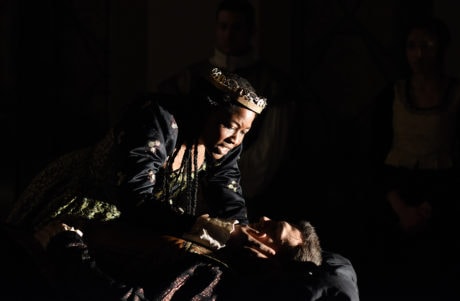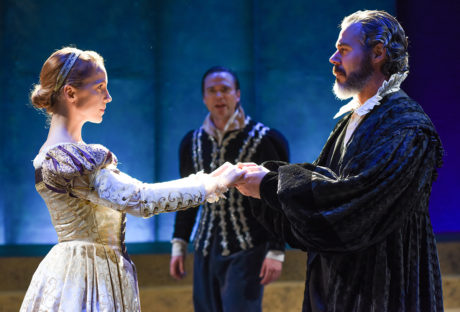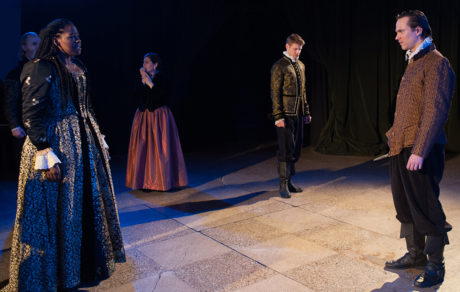It’s unlikely you will be familiar with John Ford’s The Broken Heart. Like most early 17th century playwrights not named Shakespeare, Ford’s works are rarely performed: he’s known almost exclusively for ’Tis Pity She’s a Whore. The Broken Heart was not performed between Ford’s time and 1962, when Laurence Olivier included it in the Chichester Festival’s season. It has recently begun receiving more productions, including one in New York in 2012 and a London production at Shakespeare’s Globe last year. Writing in the New York Times, Alexis Soloski attributes the current (almost) popularity of Ford’s work to a sensibility that “feels wholly contemporary,” saying “Ford is a playwright of dichotomies, somehow both restrained and outrageous, shrewd and shocking.”

Quintessence Artistic Director Alexander Burns has brought The Broken Heart to Philadelphia for the first time, pairing it with Shakespeare’s bittersweet comedy Love’s Labor’s Lost in a “Love & Longing Repertory,” performing both plays with the same cast. Lovers of English Renaissance drama should take advantage of this rare opportunity and rush to Mt. Airy to catch it, preferably on a day when both plays can be seen together, particularly to see the transformations made by several of the actors.
The play’s plot is dense: Set in an imagined classical Sparta, Orgilus (Josh Carpenter) is betrothed to Penthea (Mattie Hawkinson), who has in turn been forced to marry the older, wealthier Bassanes (Gregory Isaac) though the machinations of her twin brother, Ithocles (Daniel Miller). Ithocles in turn is in love with the king’s daughter, Calantha (Ebony Pullum), who unfortunately is promised to Nearchus (Lee Cortopassi). There’s an additional subplot involving Ithocles’ BFF Prophilus (Ashton Carter) and Orgilus’s sister Euphrania (Kristin Devine).
T.S. Eliot felt the play was diminished that all these “unfortunate personages… have an equal claim on our attention.” Burns overcomes this complaint, and the plot’s density, with a strong (mostly non-Equity) ensemble, his customary close attention to understanding and clarity of the play’s verse, a canny use of dumb show in the highly expository first scene, and a strong design team. He designed the simple but effective thrust playing space and screen across the back. Jane Casanave’s Renaissance costumes vividly individualize the characters. More important are lighting and music: David Sexton’s lighting plays across the screen and the floor, shifting moods and sometimes pulling a character in and out of our focus in almost cinematic fashion; Steven Cahill adds to the cinematic quality with original music reminiscent of Erich Wolfgang Korngold’s work in the 1930s.

The play still presents challenges. Ford was heavily influenced by his predecessors, particularly Shakespeare and John Webster, but his structure is his own: for most of the nearly three hours, despite athletic pacing, The Broken Heart has neither Shakespeare’s blend of headlong action and reflection nor Jacobean excess. In its last quarter, bodies pile up on one another (once literally) in a combination of Grand Guignol and Artaudian ritual. The tragedy of Ford’s characters results from their complex, almost modern psychologies: the Ford scholar Marion Lomax points out that Ford’s characters “are all-the-more poignant because they often reach a degree of mutual understanding when it is too late for them to benefit from it.” But these changes often seem to emerge almost from nowhere: I’m still confused about the reasons for choices made by Penthea, Ithocles, and Orgilus in the second half of the play, but Hawkinson’s, Miller’s, and Carpenter’s commitment to these choices carries the evening along. The production visually supports the play excellently, but it is still an evening that demands attentive listening throughout.
The greatest attraction of the play for a modern audience, however, may be Ford’s treatment of women. Lomax writes that “Ford was expert in the creation of defeated women who possessed great strength of will,” and the play presents two in Penthea and Calantha. When, at the end, Bassanes says “let’s all be toughness,/Without distinction betwixt sex and sex,” the sentiment is completely earned.
Of the 15-member ensemble, Michael Gamache’s Armostes and John Williams’ dual roles as Amyclas and Tecnicus deserve special attention. Janet Pilla Marini ably choreographs an important dance scene, and Ian Rose once again provides a sword fight that is convincingly chaotic and dangerous in the stage world but safe for audience members seemingly inches from the action.
Running Time: Two hours and 45 minutes, including an intermission.

The Broken Heart plays through April 23, 2017 in rotating repertory with Love’s Labor’s Lost at Quintessence Theatre Group performing at The Sedgwick Theater – 7137 Germantown Avenue (Mount Airy), in Philadelphia, PA. For tickets call (215) 987-4450, or purchase them online.




